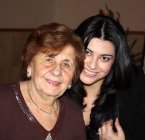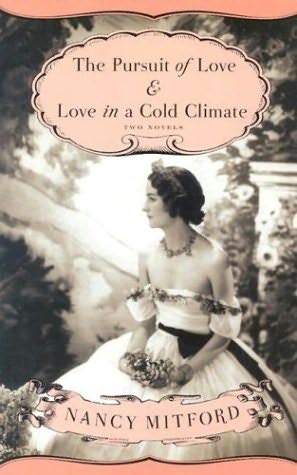
I think the trouble was that I had set my expectations too high. There has been so much written about this book, about its biting wit, its fine nuance, its subtle characterizations and its underlying sweetness. The author comes from a family of curiosities, to say the least -- two of her sisters were Nazi sympathizers (one even married Sir Oswald Mosley, founder of the British Union of Fascists), one of her sisters ran away from home and became a writer, and she herself also wrote books that were described as "maliciously witty." I had expected something akin to Waugh with undertones of Gogol. I know -- it's best never to expect anything when entering a book, but I couldn't help it. I was a victim of too much information.
Needless to say, I didn't like it. Oh, I had so wanted to like it, and I tried to like it, and I read all of it just in case there was a hidden nugget in the end that will tie everything together in such a way that will warm my heart. I hated David Copperfield and Brothers Karamazov for the first 300 or so pages, after all, but then I loved them, and, as a famous authoress said, it came on so gradually that I was in the middle before I knew it had begun. Unfortunately, no such revelation happened here.
I won't spoil the book, just in case someone wants to read it, but in general terms, I never felt for the characters what the narrator clearly felt for them, and what I think the author meant for us to feel. I lukewarmly enjoyed the portrayal of the British aristocratic society that went a little mad when faced with a foreign and changing world during the two World Wars. There are layers, and it is written cleverly and well, but there was too much sarcasm for me, too much bitterness, and I never found the sweetness that everyone was talking about. Perhaps it is because I don't belong to the class of people that Nancy Mitford describes and I cannot feel nostalgic about them; the book is never quite atmospheric enough, never quite warm enough, never quite that something that makes you like even the saddest and bitterest of narratives. Whatever it is, I felt as an outsider looking in -- my attention was engaged but my emotions never touched.
If any of you have read either of these two books, please please let me know what you thought about it. I felt very alone in my antipathy. What am I missing here?
Monday, September 22, 2008
The Pursuit of Love & Love in a Cold Climate
Posted by
Irene
at
10:56 PM
2
comments
![]()
![]()
Labels: books
Tuesday, September 16, 2008
Chocolate Covered Sables (French Butter Cookies)
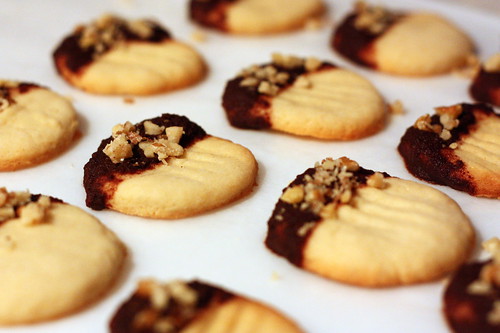
I hope you will not hate me when I tell you that I don't like cookies. I know, I know, what a weirdo. But it's true, I've always been like this, since I was a kid. There was only one kind of cookie that I've ever liked, and that is shortbread, or as Americans call it, a butter cookie. I mean, I have good taste, right, what's not to like in a butter cookie?
So the other day, I was home alone and decided that I should make a batch of cookies for some of my co-workers. I haven't fed them recently, and I was getting a little worried about the decreasing size of their waistlines. I kid, I kid. It's just that some of them have been really nice to me lately, and I wanted to say thank you. 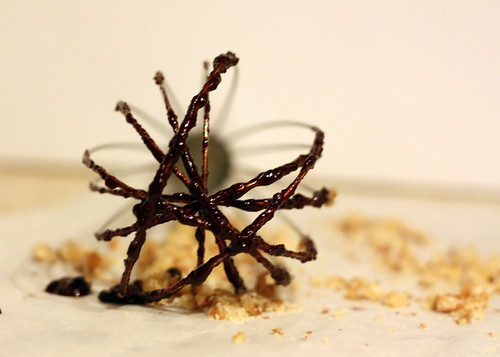
I was browsing the blog of someone whose creations consistently delight me, and I came across a recipe for a French butter cookie. I don't think I've ever tried one of those before, I thought. Check on the Irish shortbread cookie, check on the Scottish shortbread cookie, check on the American and the Russian versions, but startlingly, no French. Oh boy, did I remedy that little oversight. The cookie by itself is a great little snack, but I decided to dress it up in chocolate and crushed walnuts, and that's when it all really sang. And then I got a little cookie-happy and made this: 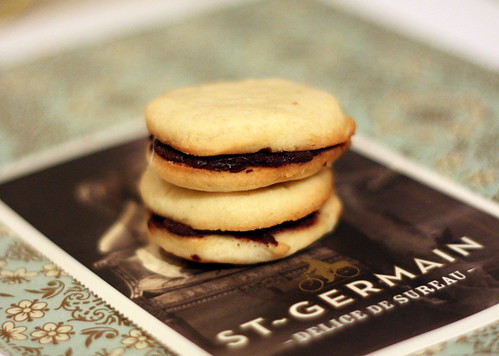
Here is the recipe for the cookies. So cute, no?
For the ganache, I whisked equal parts of dark chocolate and cream over a double boiler until smooth and shiny (mine didn't come out very shiny this time, but oh well), dipped the cookies into it, lined them up on a piece of wax paper and sprinkled with crushed walnuts. I then refrigerated for about an hour and separated the cookies by carefully sliding a knife under each cookie to release from the paper. They were really quick and easy to make and a huge hit at work! Thanks, Helen for the recipe!
Posted by
Irene
at
5:17 PM
9
comments
![]()
![]()
Sunday, September 14, 2008
Afternoon Tea, Part II - Lemon Bars

Lemon bars are my favorite dessert. There is something about the creamy, tart filling combined with a thin layer of crisp, sweet shortbread that just makes my mouth water, and even as I'm typing now, I have the biggest urge to just leave the keyboard and run to the kitchen to make another batch. But I promised you the recipe, and I wouldn't disappoint my *cough* adoring public (as A. says, I'm the queen of shameless plugs). I can tell you that this is now my favorite, go-to recipe, and I've made it twice, and twice it's disappeared faster than I could say "all-purpose flour." In fact, about 5 minutes after I gave these out at work, I heard loud moans coming from my co-worker's office, and as I crept by quietly (hoping not to catch anyone in flagrante delicto), I heard, "I LOVE YOU IRENE!" Ok, maybe that should have been a PRIVATE moment between the guy and his lemon bar, but it's always nice to know that someone loves you, even if only because you feed them. The point is, these lemon bars are GOOD and you should make them right away so that I can feel the love!
The recipe comes from my favorite dessert cookbook, that I've mentioned a bunch of times before, called Tartine. It simply rules. If I didn't already have a copy, I would go out and buy one immediately. Everything sounds delectable and everything I've made from it has been A+. There are also great hints and tips about technique that are really useful to have. Anyway, enough of my gushing, it's just that this book has really come through for me and I wanted to recommend it without reservations.
Lemon Bars on Brown Butter Shortbread (Tartine)
(yields 12 3x3 1/4-in bars, or one 9x13 baking pan)
Crust
1/2 cup confectioner's sugar
1 1/2 cups all-purpose flour
3/4 cup unsalted butter, at room temperature (for pareve, replace with margarine or vegetable shortening)
1/2 cup pine nuts (optional) - I never use these
Filling
1/2 cup all-purpose flour
2 1/4 cups sugar (I cut this down to 2 cups, because, wow, lots of sugar)
1 cup + 2 tbsp lemon juice
Lemon zest, grated, from 1 small lemon
6 large whole eggs
1 large egg yolk
pinch of salt
Confectioner's sugar for topping (optional)
Preheat the oven to 350F. Butter a 9x13-inch baking pan.
To make the crust, sift the confectioner's sugar into the bowl of a stand mixer fitted with the paddle attachment. Add the flour and stir to mix. Add the butter and pine nuts (if using) and beat on low speed until just a smooth dough forms.
Transfer the dough to the prepared pan and press evenly into the bottom and 1/2 inch up the sides of the pan. It should be about 1/4 inch thick. To help even out the crust, use the flat bottom of any type of cup, pressing down firmly. Line the crust with parchment paper and fill with pie weights. (Irene's note: I find pie weights to be a hassle, so I usually freeze the crust for 1/2 hour and line with a piece of buttered foil, buttered side down, for 1/2 of the baking time). Bake the crust until it colors evenly to a deep golden brown, 25-35 min. Rotate the pan 180 degrees if the crust appears to be baking unevenly.
While the crust is baking, make the filling. Sift the flour into a mixing bowl. Add the sugar and whisk until blended. Add the lemon juice and zest and stir to dissolve the sugar. In a separate mixing bowl, whisk the whole eggs and egg yolk with the salt. Add the eggs to the lemon juice mixture and whisk until well mixed.
When the crust is ready, pull out the oven rack holding the crust and pour the filling directly into the hot pan. (It is easier to pour the custard into the pan if the pan is in the oven.) If the crust has come out of the oven and cooled before you have finished making the filling, put it back in for a few minutes so that it's hot when the custard is poured. Reduce the temperature to 300F and bake just until the center of the custard is no longer wobbly, 30-40 minutes.
Let cool completely on a wire rack, then cover and chill well before cutting. Using a sharp knife, cut into 12 squares, or as desired. If you like, dust the tops of the squares with confectioner's sugar. They will keep in an airtight container or well covered in the baking dish in the refrigerator for up to 4 days (Irene's note - yeah, right, not a chance; good luck keeping them for more than 4 minutes).
Posted by
Irene
at
8:49 PM
6
comments
![]()
![]()
Labels: Other Yummy Desserts
Saturday, September 13, 2008
Afternoon Tea, Part I - Fruit Tartlets
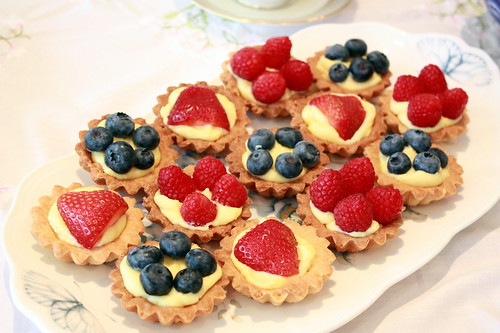
I am an unabashed Anglophile. This will come as no surprise to many, I'm sure, as I don't even pretend to hide it. I have to confess to loving England, London especially, British literature and history, TV shows and humor, cozy mysteries set in small English villages, all the lads on the Liverpool football team, and I even have a soft spot for London fog and rain because I once saw it from a floor-to-ceiling window overlooking Hyde Park, and it was an unforgettable experience. I love that one Londoner, in an irreverent and yet sweetly possessive manner, once described the Queen Mother to me as "an old biddy" who "likes her gin." I also love the fact that you can now get from London to Paris in under three hours, but that's a whole other story.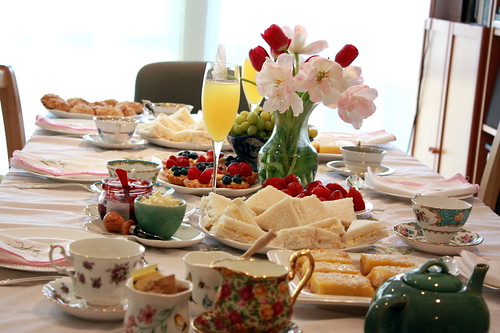
Most of all, I love afternoon tea. There is something magical about taking a break around 4 or 5 in the afternoon to drink fragrant tea and eat little bits of delicious things. It's fortifying, for the body as well as for the soul. Of course, working full time puts somewhat of a damper on the regular exercise of this charming habit, but when I do get to have afternoon tea, I like to make it a little special. Like, special with Mimosas. I'm pretty sure Mimosas are not authentic to afternoon tea, but ... what can I say? I had lemon bars, and oranges were feeling under-represented, so I had to allow them in, and then vodka just naturally followed. But, I digress. The star(s) of the show (besides the Mimosas) were these little tiny tartlets, inspired by tartlet molds I couldn't stop myself from buying at Sur La Table. So simple to make, and yet so delicious, their colorful presence at the table was much appreciated by everyone. If I hadn't hidden one or two for A. in advance, he wouldn't have gotten any. Speaking of A., an hour before the tea party, I overheard him on the phone with his friend: "My wife is having EIGHT WOMEN over for lunch and I HAVE TO GET OUT." He's lucky I'm the kind of wife who saves him food. Anyway! My point was that these babies are awesome and you will not regret making them for your next party, or just for yourself to enjoy on a quiet afternoon with a cup of tea. 
The different components of these tarts can be made a day in advance and kept in an airtight container, to be put together at your leisure. I used raspberries, strawberries and blueberries, but pretty much any fruit will do. I also did not glaze them, but you can by melting a little apricot jelly in the microwave and brushing over the top of the fruit.
Sweet Tart Dough
(Dorie Greenspan)
1 1/2 cups all-purpose flour
1/2 cup confectioner's sugar
1/4 teaspoon salt
1 stick plus 1 tablespoon (9 tablespoons; 4 1/2 ounces) very cold (or frozen) unsalted butter, cut into small pieces
1 large egg yolk
1. Put the flour, sugar and salt in the bowl of a food processor and pulse a few times to combine. Scatter the pieces of butter over the dry ingredients and pulse until the butter is coarsely cut in—you should have pieces the size of oatmeal flakes and some the size of peas. Stir the yolk, just to break it up, and add it a little at a time, pulsing after each addition. When the egg is in, process in long pulses—about 10 seconds each—until the dough, which will look granular soon after the egg is added, forms clumps and curds. Just before you reach this stage, the sound of the machine working the dough will change—heads up. (Alternatively, put the ingredients into a large bowl and cut the butter into the flour with a pastry cutter and then mix in the egg with a fork). Turn the dough out onto a work surface and, very lightly and sparingly, knead the dough just to incorporate any dry ingredients that might have escaped mixing.
2. To roll or press the dough into the pan: Butter a 9-inch fluted tart pan with a removable bottom.
* If you want to roll the dough, chill it for about 2 hours before rolling (unless you've used frozen butter and the dough comes out of the processor firm and cold, in which case you can roll it immediately). I find it easiest to roll this dough out between two sheets of plastic film – make sure to peel away the film frequently, so it doesn't get rolled into the dough.
* If you want to use the press-in method, you can work with the dough as soon as it's processed. Just press the dough evenly over the bottom and up the sides of the pan. Don't be too heavy-handed – press the crust in so that the edges of the pieces cling to one another, but don't press so hard that the crust loses its crumbly texture.
3. Freeze the crust for at least 30 minutes, preferably longer, before baking.
4. To fully bake the crust: Center a rack in the oven and preheat the oven to 375°F.
5. Butter the shiny side of a piece of aluminum foil (or use nonstick foil) and fit the foil, buttered side down, tightly against the crust. (Since you froze the crust, you can bake it without weights.) Put the tart pan on a baking sheet and bake the crust for 25 minutes. Carefully remove the foil. If the crust has puffed, press it down gently with the back of a spoon (or prick it with the tip of a small knife). Bake the crust for another 8 minutes or so, or until it is firm and golden brown, brown being the important word: a pale crust doesn't have a lot of flavor. Transfer the pan to a rack and cool the crust to room temperature.
Pastry Cream
(adapted from Dorie Greenspan)
2 cups whole milk
1 tsp vanilla extract
6 large egg yolks
1/2 cup sugar
1/3 cup cornstarch, sifted
3 1/2 tablespoons (1 3/4 ounces) unsalted butter, softened and cut into 3 pats
1. Bring the milk a boil in a small saucepan over medium heat.
2. Whisk the yolks, sugar, and cornstarch together in a heavy-bottomed medium saucepan. Whisking constantly, drizzle one-quarter of the hot milk over the yolks. When the yolks are warm, whisk the remainder of the milk into the yolks in a steadier stream.
3. Put the pan over medium heat and, whisking vigorously, bring the mixture to the boil. Keep at the boil—still whisking energetically—for 1 to 2 minutes before pulling the pan from the heat and pressing the cream through a sieve into the small bowl. Stir in vanilla extract. Let the cream sit for 5 minutes, then whisk in the butter. Cover the cream with a piece of plastic wrap—press the wrap against the cream—and refrigerate until thoroughly chilled. You can speed up the chill by putting the bowl in a larger bowl filled with ice cubes and cold water. (Keeping: Covered tightly with plastic wrap, pastry cream can be refrigerated for 2 days. To smooth the chilled cream, whisk it for a few seconds.)
Posted by
Irene
at
4:24 PM
9
comments
![]()
![]()
Labels: Breakfast and Brunch, Pies and Tarts
Friday, September 12, 2008
Something Beautiful
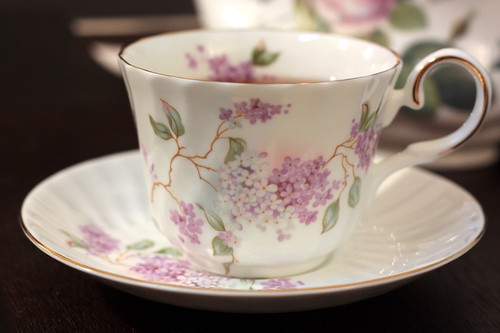
This first installment of my little new idea was A.'s present to me for my birthday. I wanted to share it with you because of the way it made me feel. Having beautiful things around counterbalances everything else life throws at us, and even though they are just things, beauty always touches a hidden part in every person. John Keats famously said:
'Beauty is truth, truth beauty,—that is all
Ye know on earth, and all ye need to know.'
I didn't really understand what he meant when I first read this poem at 17, but I think I do now.
Posted by
Irene
at
9:35 AM
3
comments
![]()
![]()
Thursday, September 11, 2008
9/11

There are so many things one wants to say. I'm sorry. And I remember. And I'm proud. Not the ebullience of misplaced patriotism, but the proper pride of one who has known what else is out there, and of one who is grateful to have been given (yes, given, offered, allowed), finally, a home. I will always mourn for the losses of my country, and I will always rejoice for its triumphs and work to fix its mistakes, and most of all, I will always be proud to be an American, and that is a promise.
Posted by
Irene
at
8:28 AM
1 comments
![]()
![]()
Wednesday, September 10, 2008
Vanilla Cake, Filled With Custard and Fresh Raspberries, Swiss Buttercream Icing

{small voice: don't judge me for the icing efforts, people, it was my first time}
Once upon a time (a bit more than 3 years ago, to be exact), on a sunny June day, we ate a cake with all of our closest friends and beloved family. Ok, it was more like 1:30 am by the time we actually cut into it, but it was inextricably part and parcel of a day that (and I'm trying really hard to avoid all cliches here) I keep in a sealed corner of my mind, to return to in the rainy moments of life. A day, the simple memory of which, is guaranteed to make me happy.
Smiling goofily, we read our vows in English and in Hebrew, and I think I might have promised him my heart and he might have promised to give my dad some goats. I wasn't following too well, and the Hebrew vows are something like 5,000 years old, so I was pretty sure I could catch up later. But the cake was really awesome. The cake had a story, it was a whole saga, in fact. Now, if you don't live in Los Angeles (or New York), you'd better sit down when I tell you that bakeries want to charge a starting price of $6.50 per slice of wedding cake. That's for a plain cake with plain frosting with no decorations. If you dare to want some piped flowers, and maybe some fruit, you will be paying close to $10 (that's per slice). That is not including tax, a hefty delivery fee (even if the bakery is within a mile from your place of choosing), and a cutting fee if your place of choosing happens to be anything other than a private residence. I wonder that they don't make you buy the cake flour. When A. and I sat down and calculated that we would have to pay two thousand dollars for a cake, I think I might have fainted for a little bit. I mean, do you know how many cakes I could make for two thousand dollars? And worst of all was that I pretty much hated all the cakes I had so diligently tested from supposedly "famous" bakeries. Dry, crumbly, with icing that was at once flavorless and too sweet... and don't even get me started on fondant. Yuk.
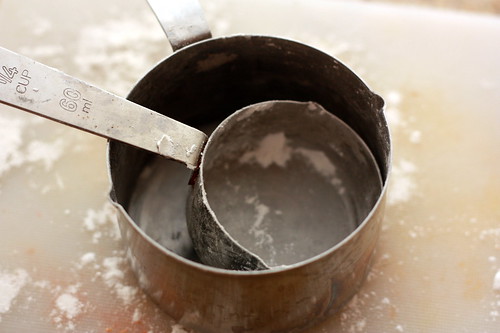
I was on the verge of doing something crazy (ordering 200 cupcakes - whoah, Irene, move away from the ledge), when my dearest mom remembered a tiny French bakery close to her house in Santa Monica, and off we went. The second I saw Jean-Louis, and more importantly had smelled some of his creations, I knew we were in good hands. He looked -- he looked like a guy who bakes cakes. That's the only way I can describe him. By the end, I was ready to kiss him (and, drunk on the petite fours he pressed on us, I think I just might have. Sorry, A.). Long story short (too late), he baked our cake for the staggering price of $2.50/slice, and the cake was so unbelievably awesome that we kind of ditched the whole idea of freezing the top and ate the leftovers the next day for brunch. Since then, I have been living with the idea of duplicating this cake. I can't say that I've done it, because, you know, he's Jean-Louis and fabulous, and I'm me with a hand mixer, but this cake is so great that even my GRANDMOTHER (woman who never praises other people's food and who is skeptical of me trying to boil water), called me the next day and said that the cake was "really good." I might have fainted again. 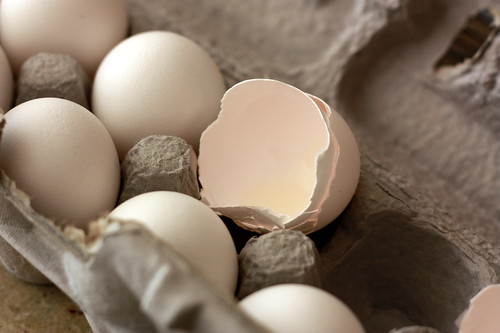

My cake-making phobia was eased into mild panic when Deb from SmittenKitchen made a wedding cake (crazy... awesome... crazy...). My mission was on a much lesser scale -- I was to make a cake for my sister's birthday brunch with 40 people. Ok, I thought, I can handle this. I decided on a 1/4 sheet (a 9x13) vanilla cake with three thinner layers, filled with custard and fresh raspberries, and iced with buttercream. This, in my personal dictionary, is listed under "Jean-Louis" and "taste bud heaven." There were going to be three components to my cake: the cake, the custard (pastry cream), and Swiss buttercream. 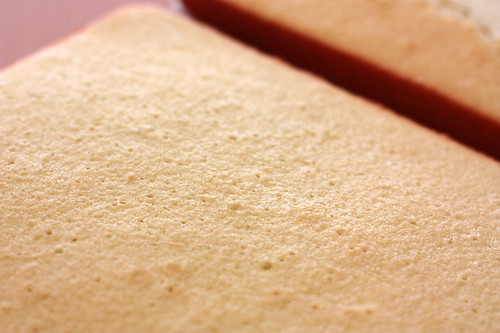
The cake was a cinch to bake, turned out beautiful, fluffy and golden, and is an absolute smashing keeper of a recipe. I added the zest of two lemons to the batter and the hint of lemony flavor brought out the tartness in the raspberries to perfection. The recipe made three perfect 1 inch 9x13 layers, which was exactly what I had envisioned. So far, so good. The custard also didn't give me any trouble. It was a pastry cream recipe from one of my favorite dessert books, Tartine, and I made a batch and a half just to make sure I would have enough. It's lighter than real French pastry cream, but with the heaviness of butter in the cake and with buttercream, I figured I needed to cut some calories or people would revolt. The Swiss buttercream, on the other hand... ... ... let's not get into that, I'm still a little scarred. After some tears, adjustments to my A/C and possibly whisk-throwing, I braved it through (it's true what they say, whip, whip, whip), and it did finally come together. And the result was as follows: my two uncles, forks in hand, stealthily slicing off tiny bits of the last few slices of cake in the kitchen, and my mom coming at them armed with her scariest frown and taking away the leftover cake because she wanted it for herself. Such are the cake trials and tribulations at Chez Irene. Ok, without further ado, here are the recipes:
Vanilla Buttermilk Cake
Swiss Buttercream
Pastry Cream (Tartine) - 2.5 cups
(I made 1.5 batches of this for my 9x13 3 layer cake)
2 cups whole milk
1/2 cup + 1 tbsp sugar
2 large eggs
4 tbsp unsalted butter
1/4 tsp salt
3 to 4 tbsp cornstarch (depending on how set you want the pastry cream to be)
1 tsp vanilla extract
Pour the milk into a heavy saucepan. Add the salt, place over medium-high heat, and bring to just under a boil, stirring occasionally. Meanwhile, whisk together the cornstarch and sugar. Add the eggs and whisk until smooth (don't let the eggs and sugar stand together for too long or else the sugar will cook the eggs *so I've heard*).
When the milk is ready, slowly ladle about 1/3 of the hot milk into the egg mixture, whisking continuously. Pour the egg-milk mixture back into the hot milk and continue whisking until the custard is as thick as lightly whipped cream, about 2 minutes. The mixture must come just to the boiling point (slow bubbles, not boiling vigorously, or you will curdle the eggs, yuk). Remove from heat and immediately pour through a sieve into a bowl (or not, like me). Stir in the vanilla extract. Let cool for 10 minutes, stirring occasionally. Cut the butter into 1 tbsp pieces and whisk into pastry cream 1 tbsp at a time until smooth.
Cover the bowl with plastic wrap, pressing directly onto the top of the cream to prevent a skin from forming and put in the refrigerator to cool. If using fresh fruit like raspberries, carefully fold into pastry creme before spreading between the layers of the cake. Seriously, people, this is really good!
Posted by
Irene
at
11:48 PM
5
comments
![]()
![]()
Labels: Cakes
Catherine de' Medici

If you are only interested in cooking, sorry, guys, I have a smashing cake recipe coming up later on this week, but it's just a quickie today and you will have to anticipate in mystery a little longer.
I'm reading a new book that I have sort of dual conflicting feelings towards (ha! I'm a Gemini!). It's called Catherine de Medici, Renaissance Queen of France by Leonie Frieda. It's a wonderful book, really fast paced and dynamic and well written. I can tell that the author did a great deal of research -- it shows in a great many ways, in small details such as the cost of Catherine's jewels upon her marriage and the clothes she wore to the coronation, the tender letters to her daughter and the complex portrayal of relationships. All the brilliant personages of 16th century France make their mark in the pages of this book, and they are alive, oh so alive! Much is explained, many myths de-mystified. Believe it or not, I had gone through at least 150 pages before I could put the book down.
But the more I read, the more I feel like there is too much indulgence, that the biographer has done the unforgivable and fallen ever so slightly in love with her subject. It's an understandable thing. Catherine was an entirely fascinating woman, brave and tenacious in the face of many disasters, loving and loyal to her children. In common parlance, girlfriend was a fighter. It's easy to ascribe the highest motives to someone like that, it's easy to say she loved France with all her heart and did what she did for the country. It's easy to say that circumstances were such, and there was no other choice, and she was left in an untenable situation by her spendthrift jerk of a husband, and I get it. However, what emerges despite the indulgence is that she did what she did to survive, to simply survive, and she liked power and wished greatly to keep it for herself and for her children. Which is not a thing to disprespect, but I can't just brush aside all the bad decisions as easily as Leonie Frieda does in her book. We all know the thing about "good intentions."
I would highly recommend this book. There is a multifaceted portrait here to be discovered, and it's just damn good reading. What's next on my list? Peter the Great, and just wait until I get to the Tudors (mwahahaha). :)
Posted by
Irene
at
5:35 PM
1 comments
![]()
![]()
Labels: books
Tuesday, September 9, 2008
Banana Bread or Miles To Go Before I Sleep
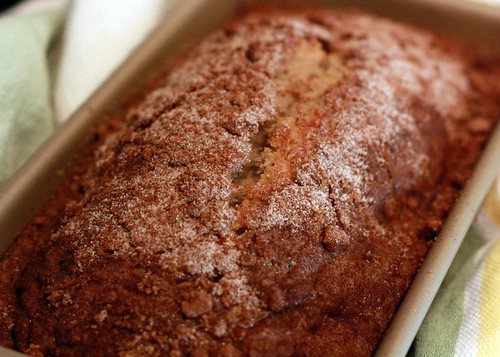
The woods of Maui are "lovely, dark and deep," though different as can be from the snowy, quiet woods of Robert Frost. There is a velvety, exotic darkness there, the sun glinting off the edges of the trees that whisper in the wind, the chirping of a thousand birds, the myriad of colors overwhelming the senses (who knew there were so many version of green?) and the perfume of red and yellow hibiscus flowers wafting in heady waves over the whole island. It's a magic place that borders alternatively on sandy pockets of beach and scraggly rocks hiding emerald tide pools. The kind of place that's full of bends in the road, just waiting to be explored. Which, if you know me at all, is something I can never resist.
I bought a guide book (yes, I organize things, even on small islands), and amidst the usual restaurant recommendations, there was buried in the middle a map for a route going north, the part of the island that isn't usually featured in advertisement brochures, which intrigued us greatly. There was one sentence there, too, which said something like, "before you begin on this route, there is on the left of the road a tiny stand with an old lady selling the best banana bread you've ever eaten." Ha, ha, we thought, watch it be tough as a brick. But because we are suckers for banana bread, we totally bought half a loaf (that was the smallest measure we could get, and the old lady looked at us reproachfully behind the weather beaten stand). Well, ok, it wasn't the BEST banana bread, but it was pretty close -- surprisingly moist, dark, laced with soft specks of banana, fresh with flavors, oh yeah, it was exactly what we needed to fortify us for the journey (which was, in one word, amazing, as is everything on Maui -- can you tell I love the place?).

Since then, I've made a lot of food, but somehow, I just haven't gotten around to exploring banana bread recipes. It's like never going out to eat at the cafe in the corner because you know it's always been there. It just didn't seem challenging enough. Boy, was I wrong. I had no idea how many banana bread recipes there were or how hard it would be to choose one, never having made banana bread before and not really knowing what any of them would taste like. I picked a recipe from a summer Bon Appetit that had an interesting cinnamon crumble topping (let me save you the suspense -- I was wrong). It wasn't... bad exactly. Just not really good. Not *that* good. Not small-stand-on-Maui-banana-bread good. It was moist, but there wasn't enough flavor. You really couldn't taste much of the bananas, and certainly not the wonderful tea honey that I used (grr... note to self: eat fancy honeys, not use them in recipes; another note to self: maim you after the meeting*). In one way, I was disappointed because I had so hoped to hit on a winner, but in another way, this leaves me to try many other banana bread recipes! Who am I to complain about something like that?! Here's the recipe below, just in case. Watch out for more B-Bread experiments in the future (and that, as Martha would say, is a good thing).
By the by, I would love to see your favorite B-Bread recipes, so shoot me an email or leave a comment. Girl seeking yummy banana bread, will bake for food!
*Shout out to my friend Will in honor of us being dorky and watching Disney's "Hercules" while pretending to study economics. Tsk, tsk.
Banana Bread With Cinnamon Crumble Topping (Pareve)
(Bon Appetit, sometime this summer)
1 1/2 cups all purpose flour
1 cup plus 2 tbsp sugar
2 tsp ground cinnamon, divided
1 tsp baking soda
1/2 tsp salt
1 cup mashed ripe bananas (2 to 3)
2 large eggs
1/2 cup vegetable oil
1/4 cup honey
1/4 cup water
2 1/2 tbsp (packed) golden brown sugar
Preheat oven to 350F. Butter and flour 9x5x3-inch metal loaf pan. Whisk flour, 1 cup sugar, 1 tsp cinnamon, baking soda and salt in medium bowl. Whisk next 5 ingredients in large bowl until smooth. Add dry ingredients; stir to blend. Transfer batter to pan. Mix 2 tbsp sugar, 1 tsp cinnamon and brown sugar; sprinkle over batter.
Bake bread until tester inserted into center comes out clean, about 1 hour. Cool bread in pan 30 minutes. Turn pan on its side; slide out bread, being careful no tto dislodge topping. Turn bread right side up and cool completely.
Posted by
Irene
at
9:48 AM
6
comments
![]()
![]()
Labels: Quickbreads



